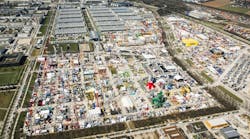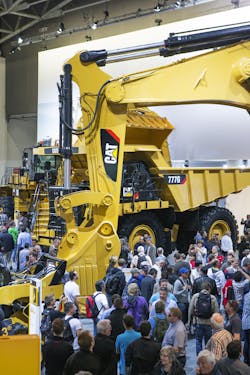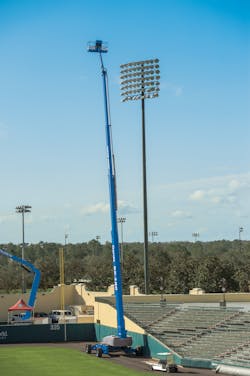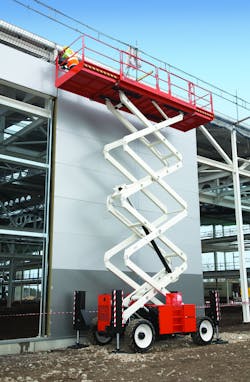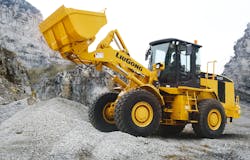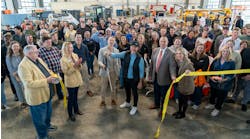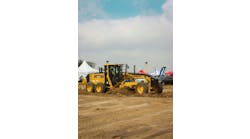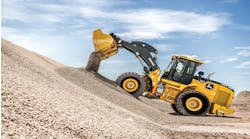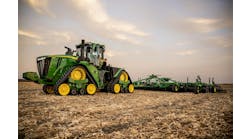Postcards from Bauma the World's Biggest Construction Equipment Show
Genie’s 180-foot boomlift turned a lot of heads at Bauma. The SX-180 self-propelled telescopic boomlift is the largest of its kind on the market, designed for applications in the oil and gas industries, commercial construction, industrial construction and maintenance, and general maintenance.
The 180 has a 180-foot vertical reach and 80-foot horizontal reach, with an 8-foot by 3-foot platform and an unrestricted capacity of 750 pounds, and has a 10-foot, 180-degree rotating jib.
“The whole idea was really generated from existing customers who said, ‘Our businesses are going higher, we have more work at higher elevations, we need the control the boom gives us, what can you do to help us?’ said Scott Krieger, senior product manager, booms and telehandlers, Terex Aerial Work Platforms. “So we met with a bunch of customers, we did a lot of research, and we compiled it all and developed the SX-180.”
Krieger pointed out that when working at 180 feet, workers don’t want to go down and come up very often since it takes about five minutes in each direction. So, the machine is designed to be driven at full height. Travel speeds vary based on boom position and range from 2.5 mph with the boom in the stowed position, 0.4 mph below 125 feet and 0.1 mph above 125 feet.
The newly designed X-chassis extends and retracts to provide both stability on the job and a narrow profile for transport.
“If I’m up at 180 feet, I want to make sure I have a stable and safe foundation,” said Krieger. “It has a wide platform to work on but when it comes time to transport, it has no over-width requirement.”
The boomlift’s stowed dimensions are 10 feet in height and 8 feet, 2 inches wide. With a stowed length of 42 feet, 7 inches, the 54,000-pound machine is designed to be easily transported.
“This X-chassis design is also used on our new Genie ZX-135 articulating boom introduced earlier this year,” said Krieger. “This allows our big booms to share many design features providing parts and operating commonality.”
New platform controls consist of toggle switches and fully proportional jib and boom controls. The ground controls offer an updated function diagram layout and tactile membrane switches. Customers may choose from either a Deutz or Perkins engine. A 50-gallon fuel tank for longer run time and a 7.5-KW generator are standard equipment.
“We can see the market moving bigger,” said Matt Fearon, president of Terex Aerial. “It’s not just about the physical specs of having the highest height; it’s about where we see the industry going. So the big spec is platform height. One of the other key specs is the weight. We’ve been able to keep that weight to where [rental companies] can transport it and that’s a key differentiator with this product.”
Ron DeFeo, Terex chairman and CEO, says the machine’s stability is another key. “This is a technological reach, the 180,” said DeFeo. “It’s not just about making a boom that goes a little bit higher. It’s about understanding the stresses of that boom, understanding how you can operate that work platform in a way that’s comfortable for people.”
The new SX-180 is expected to be available worldwide in the second half of 2013.
Fearon said the 180 is one of the key reasons he expects Terex’s aerial division to increase revenue from $1.8 billion to $2.9 billion by 2015. But Fearon sees lots of reasons for Genie’s potential growth.
“If you look at what’s going on in the North American market, it took off in late 2010, and it’s been very robust for the past couple of years, but it’s all driven by replacement,” Fearon said at Bauma. “In other words, commercial construction and housing have not picked up yet; those are going to continue to help us move forward. If you look at Europe, Europe has still not recovered; it has just now started getting into the replacement cycle. We have opportunity as China grows, as Latin America grows, as the Middle East grows, Eastern Europe, Russia, you name it. Aerial work platforms still have a long way to go globally and that’s going to give us some further growth.” Growth will also come, Fearon added, from the SX-180 and other new Genie products.
Terex also expects positive developments and growth in its other businesses. DeFeo was effusive in discussing the changes in Terex, beginning by describing his first Bauma — 21 years and seven Baumas ago — when the company had “two ugly green trucks in the outer hemisphere in some lot called Terex.
“I couldn’t have imagined the stand and team we have today. I feel blessed but I feel energized by the need to continue to change our company. Today we stand for being a lifting and material-handling solutions company. We’ve grown through acquisitions but our focus today is on operational improvements.”
DeFeo’s overall outlook for 2013 and beyond is bullish.
“Our fiscal year 2012 revenue was $7.3 billion, we expect about $8 billion of revenue in 2013,” he said. “Our revenue by product type is split pretty evenly. Cranes represent 27 percent of our business, material handling and port products 23 percent; materials processing, or our crushing and screening business, 9 percent; aerial work platforms 23 percent, and our construction business is 18 percent. We’re pretty excited about the diversity of our company; we set out to be about a third in the Americas, about a third in Europe and about a third in the rest of the world, and we’re not far from that goal as we sit here today.”
As for the next few years, DeFeo expects to increase Terex’s revenue, $7.35 billion in 2012 to about $10 billion in 2015, with $1 billion in operating profit, a 10-percent operating margin compared to a 6.4-percent margin in 2012. And despite Terex’s history as a company that grew by acquisitions, DeFeo said he expects the increase to happen without acquisitions.
“They say zebras never change their stripes, but the reason I laid those numbers out is because I wanted to demonstrate that the opportunity for us to achieve great things is within our own executional control,” DeFeo said. He pointed out that the company’s most recent acquisition — that of German crane manufacturer DeMag Cranes — is still a work in progress, with a lot of work yet to do to make that business segment as effective and profitable as it needs to be.
“So we don’t need to make another acquisition to really grow the company. I really do believe there’s a lot of opportunity in our existing operations.”
Most manufacturers present new product at Bauma, with many companies planning a couple of years in advance to introduce their latest and greatest to the largest audience in the world. But Bauma also serves as an opportunity for customer feedback with many exhibitors presenting prototypes of new machines to see what customers think, and then taking back the feedback to make final adjustments.
Snorkel took advantage of the international crowd to show off prototypes of its new 43-foot and 52-foot platform-height scissorlifts. The two machines are essentially the same but with a slightly different scissor stack.
“One of the main focuses of the machine is, first and foremost, the stack rigidity,” said Bert Rayer, Snorkel regional sales manager. “You cannot go up in a machine and feel like it’s flailing around. We worked hard on optimizing the stacks on these machines to increase the rigidity. We’ve done some different things as far as the cross tubes go. We’ve added cross tubes to the outer arms. Every scissor out there has got the inner members tied together. What everybody doesn’t do is tie the outer members together. It gives us the ability to help control the torsional twist on the outer arms as well as the inner arms.”
Snorkel also lengthened the outriggers on the units. “They’re taller so we have more of a stroke,” said Rayer. “We can level on a more extreme angle.” The longer outriggers helps the machines climb out of ditches more easily.
Snorkel, which has shown the prototypes to distributors in the U.S., brought the machines to Europe to get more of a global reaction and then will likely make a few adjustments before marketing the machines in the U.S. later this year or early next year.
“You want it to be a customer-focused machine,” Rayer added. “It doesn’t matter what I think. I need to make it stable, safe and strong. Other than that, the customer is going to be the dictating factor. We introduce it here so all these people can see it. Somebody will use the machine for a purpose that we hadn’t really thought about so if there’s something we can give them or an option we can make to make it work better for that customer, that’s what we want to do.”
Suitable for rough-terrain applications, the S4390RT has four-wheel drive, an oscillating axle, 14 inches of ground clearance and can traverse gradients of up to 50 percent. Drivable at heights of up to 29 feet, 6 inches, standard features include automatic self-leveling hydraulic outriggers for quick deployment.
U.S. president Dave Smith said showing a machine at Bauma is the perfect forum. “Where else can you get such global input?” he said.
When Japanese construction companies began introducing their products in the United States 25 or 30 years ago, U.S. equipment users, distributors and rental companies were uncertain. The “buy American” philosophy was strong in the 1980s. Takeuchi, Komatsu, Kubota and others were new to the U.S. market. It took awhile, but eventually the quality of these and other Japanese manufacturers became known and their products accepted in the U.S. marketplace.
A similar evolution is taking place in regard to Chinese manufacturers. One that is beginning to gain some traction in North America is LiuGong, a company that has a 55-year history and is currently distributing in more than 25 countries in the Americas, Africa, Asia and, most recently, the U.K. LiuGong also recently acquired Polish manufacturer Dressta and operates the factory formerly owned by Dressta in Poland. LuiGong had a strong presence at Bauma, showing 22 machines, including wheel loaders, excavators, motor graders, rollers, skid-steer loaders and forklifts.
While LiuGong might seem like a newcomer to North American rental companies, the company is one of the world’s largest wheel loader manufacturers — it has been producing them in China since 1966 — and is a major player when it comes to excavators, forklifts and skid-steer loaders as well. It has had a joint venture going with German manufacturer ZF since the mid-1990s making transmissions and axles for construction machinery.
In 2011, LiuGong established a joint venture with Cummins to build wheel loaders. In March of this year, 18 months after the joint venture was launched, the Guanxi Cummins Industrial Power facility, jointly owned by Cummins and LiuGong, opened in China and the first L9.3 engine was produced, an engine designed for wheel loaders.
The JVs are part of an effort by LiuGong to control its supply chain. “When we install engines and driveline components precisely designed and manufactured for our machines, we are able to optimize the integration of these components,” said David Beatenbough, LiuGong’s vice president of research and development. “It is easy to bolt off-the-shelf parts together, and such machines will work, but not at the highest levels of efficiency. For maximum efficiency, we must work very hard to integrate different components together, matching their performance and specifications carefully.”
This type of attention to detail appears to be a major part of LiuGong’s way of doing business. While it has been working in North America for about five years, it is progressing slowly, quietly building a dealer network. LiuGong now has more than 20 dealers in North America and is committed to growing that network.
“We’re looking for the right people in the right places where we have open territories,” said Dan Collins, deputy general manager of global after-sales development and vice president of North America operations. “Our business model is that we really don’t go into a market and bring product until we have parts and support behind it. That’s why we don’t bring all our models to North America. We need to be able to support them.”
“In the United States, we are focusing on earthmoving machines,” added Jordan Huang, chairman of the board of LiuGong North America. “Wheel loaders, excavators, and backhoe loaders. We also have forklifts and are looking for forklift dealers as well.”
Collins said the rental market is very important to LiuGong.
“It’s one of the best approaches to introduce people to our machines and we’re very confident that once people get into our machines, they will like them,” he said. “That has been our history. Rental is the key to growing our footprint starting out.”
Collins and Huang said most LiuGong dealers in North America have their own rental fleets and are well established in rental. One of its better known U.S. dealers, with a fast-growing rental program, is recently established Noble Iron, based in Houston and led by former Hertz and Stephenson’s Rental executive Willie Swisher.
Now that LiuGong has established its base in North America, it will be developing its infrastructure more quickly. It recently launched a three-year, 4,000-hour full-machine extended warranty on all its machines, including Dressta dozers. The warranty is offered standard, free of charge, Collins said.
LiuGong, currently based in Kady, Texas, is planning to build a new North American headquarters, which will be the regional after-sale center for North and Central America, including a training center, equipment demonstration area, new equipment storage, parts warehouse and assembly capabilities.
LiuGong will also enter the 50-metric ton hydraulic excavator market in North America in the third quarter and is already taking advance orders.
Perkins presented its new Tier 4 854F-E34TA 3.4-liter engine, designed to meet EPA Tier 4 final emission standards for machines higher than 75 horsepower, at Bauma along with its other lines of Tier 4 final engines. The model incorporates selective catalytic reduction technology for the first time, packaged separately from the diesel oxidation catalyst module. The engine can be mounted in either a horizontal or vertical position giving manufacturers of compact equipment greater flexibility in installation.
Space saving is further enhanced by the absence of a diesel particulate filter, made possible by the introduction of a four-valve cylinder head and increasing the common rail fuel pressure. Performance from the 854F-E34TA has been boosted to 121 hp thanks to a single-stage turbo with smart wastegate.
Perkins has developed a collaborative method of working with OEMs called Technology Integration Workshops where engineers from Perkins and the OEM work side by side in a purpose-built facility to simplify resolution of challenges faced by the OEM in trying to integrate engines into their machines. The workshops were initiated in 2008 as engine manufacturers and OEMs were trying to resolve technology and engineering issues related to Tier 4 interim standards.
Perkins invested in a collaboration center onsite, featuring engineering software tools that allow installation capabilities to be explored virtually. Packaging challenges can be looked at without cutting metal. In advance of the workshop, engineers use a CAD model of the application to create an engine-design specification.
“In typically two to three days, we can achieve together what used to take weeks if not months,” said TIW leader Nick Stephenson.
“With compact machines you don’t always have a choice of where you can put things,” said Perkins marketing manager Allister Dennis. “We try to give the OEM some choices and some flexibility. Sometimes we spend two or three weeks working together with the machine customers modeling to get to the specification quickly. Sometimes we find a different place to put the battery or [other component], and then use the space for the after-treatment system.
“For an integration workshop we’ll say ‘send us machine models’ and we’ll pull together what we think is a starting point for specs and we’ll see if it fits, and then adjust things as we need to. It could be multiple models and engine installations over a few days and we put them side by side. ‘Well, this didn’t quite fit here, so let’s try moving this.’”
While Perkins’ headquarters is in Peterborough, U.K., it manufacturers in a number of facilities around the world, including in the United States in order to manufacture its engines as close to the customer as possible.
The launch of the 854F-E34TA at Bauma marked the completion of Perkins Stage IV/Tier 4 Final engine range, which includes the Perkins 400 and 1200 Series. rer
